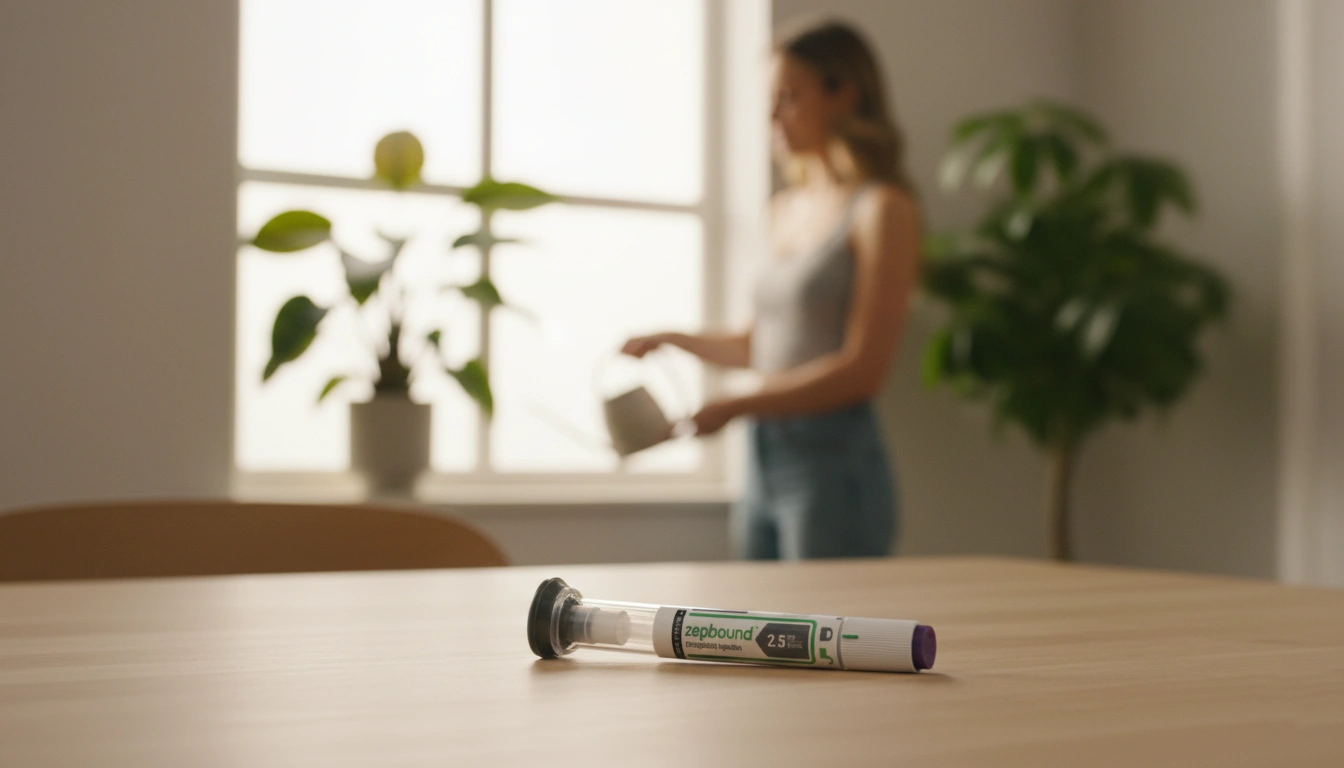How to Determine Zepbound Maintenance Dose: A Comprehensive Guide

Introduction
For individuals grappling with obesity, seeking effective weight management solutions has never been more crucial. Did you know that obesity affects over 42% of adults in the United States? This staggering statistic underlines the importance of exploring innovative treatment options like Zepbound, which utilizes the active ingredient tirzepatide. Understanding how to properly determine the maintenance dose of Zepbound is vital for achieving optimal results and ensuring a safe treatment journey.
In this blog post, we will delve into the intricacies of determining the Zepbound maintenance dose, examining the dosing protocols, factors influencing dosage adjustments, and the importance of personalized treatment plans. Our goal is to equip you with the knowledge necessary to navigate your weight-loss journey effectively and safely while emphasizing the role of medically supervised care in this process.
By the end of this post, you will gain a thorough understanding of how to determine the appropriate maintenance dose of Zepbound, factors influencing these decisions, and the significance of a tailored approach to weight management. We will also highlight the importance of engaging with healthcare professionals throughout your treatment journey to ensure you make informed decisions.
Understanding Zepbound and Its Mechanism of Action
Before diving into the specifics of dosing, it’s essential to understand what Zepbound is and how it works. Zepbound is an injectable medication designed to assist adults with obesity or overweight, particularly those with weight-related health conditions. Its active ingredient, tirzepatide, is classified as a GLP-1 receptor agonist, which mimics the effects of naturally occurring hormones to regulate appetite and caloric intake.
Tirzepatide operates through several mechanisms:
- Appetite Suppression: By acting on the brain's appetite regulation centers, it helps reduce hunger and increase feelings of fullness.
- Glycemic Control: It regulates blood sugar levels, which can be particularly beneficial for individuals with type 2 diabetes.
- Delayed Gastric Emptying: This mechanism slows the rate at which food leaves the stomach, contributing to prolonged satiety.
Understanding these mechanisms is pivotal in appreciating how Zepbound can facilitate weight loss and the subsequent need for appropriate dosing adjustments over time.
The Dosing Protocol for Zepbound
Initial Dosing and Titration
The initiation of Zepbound treatment typically begins with a conservative approach. The recommended starting dose is 2.5 mg, administered subcutaneously once a week. This initial dose is crucial for allowing the body to adjust to the medication while minimizing potential gastrointestinal side effects.
After four weeks, if well-tolerated, the dose should be increased to 5 mg once weekly. This titration continues, with the option to increase in 2.5 mg increments every four weeks, ultimately reaching a maximum dose of 15 mg weekly, depending on the individual’s response and treatment goals.
Recommended Maintenance Doses
The recommended maintenance doses of Zepbound vary based on the treatment goals:
- For weight reduction, the 5 mg, 10 mg, or 15 mg doses are recommended.
- For individuals diagnosed with moderate-to-severe obstructive sleep apnea (OSA) in conjunction with obesity, the 10 mg or 15 mg doses are advisable.
Understanding these recommendations is pivotal for healthcare providers and patients alike as they navigate the complexities of weight management.
Factors Influencing Dose Determination
Several factors influence how we determine the appropriate maintenance dose of Zepbound. At TrimRx, we believe in a personalized approach, ensuring that every individual's unique needs are considered when making dosing decisions.
1. Individual Health Profile
Each patient's health condition, including any comorbidities or medication interactions, must be evaluated. For instance, individuals with a history of gastrointestinal issues may require a slower titration to mitigate side effects.
2. Response to Treatment
Monitoring how well a patient responds to the initial doses is critical. If significant weight loss is achieved with fewer side effects, a higher maintenance dose may not be necessary.
3. Tolerance to Side Effects
Tolerability is another essential consideration. If a patient experiences adverse reactions, such as nausea or gastrointestinal discomfort, their healthcare provider may recommend a lower maintenance dose or a slower titration.
4. Lifestyle Factors
Diet, exercise, and overall health habits play a role in the effectiveness of Zepbound. A comprehensive evaluation of these factors can guide healthcare providers in making informed dosing recommendations.
Importance of Medical Supervision
At TrimRx, we emphasize that weight management is a collaborative process. Engaging in regular consultations with healthcare professionals ensures that patients receive the necessary support and guidance throughout their treatment journey.
Personalized Assessment
Taking our free assessment quiz can help determine eligibility for prescription weight loss medications, including Zepbound. By understanding your unique health profile, we can tailor a treatment plan that suits your needs. You can take the assessment here: Quiz Conversion.
Continuous Monitoring
Regular follow-ups allow for continuous monitoring of progress and side effects. Healthcare providers can make timely adjustments to the maintenance dose based on observed outcomes, ensuring optimal effectiveness.
Adjusting the Maintenance Dose of Zepbound
When to Adjust the Dose
Adjustments to the maintenance dose may be necessary based on two primary scenarios:
- Insufficient Weight Loss: If a patient does not achieve the desired results at the current maintenance dose, their healthcare provider may suggest an increase.
- Adverse Reactions: If a patient experiences intolerable side effects, a reduction in the dose may be required.
Guidelines for Adjustment
- Increase Dose: When considering an increase, it’s essential to wait at least four weeks after the last dose adjustment to gauge effectiveness and tolerability.
- Decrease Dose: If side effects are persistent, the dose should be lowered, and the patient should be monitored closely for improvement.
Lifestyle Considerations with Zepbound
While Zepbound is a powerful tool in the fight against obesity, it is most effective when combined with lifestyle changes. A reduced-calorie diet and increased physical activity are essential components of a successful weight management plan.
Dietary Recommendations
Incorporating a balanced diet rich in whole foods can enhance the effectiveness of Zepbound. Focus on:
- Fruits and Vegetables: Aim for a variety of colors to maximize nutrient intake.
- Lean Proteins: Include sources such as chicken, fish, legumes, and nuts.
- Whole Grains: Opt for whole grains over refined grains to increase fiber intake.
Exercise Recommendations
Regular physical activity can significantly impact weight management outcomes. Aim for at least 150 minutes of moderate-intensity exercise per week, which may include:
- Aerobic Activities: Walking, cycling, or swimming.
- Strength Training: Incorporate resistance exercises at least twice a week.
Common Side Effects of Zepbound
Being aware of potential side effects is crucial for patients using Zepbound. Common side effects include:
- Nausea
- Diarrhea
- Vomiting
- Constipation
- Abdominal pain
While many patients tolerate these side effects well, monitoring and reporting any adverse reactions to healthcare providers is vital. Open communication ensures that appropriate adjustments can be made to the treatment plan.
Conclusion
Understanding how to determine the maintenance dose of Zepbound is essential for individuals embarking on their weight loss journey. By engaging in a personalized, medically supervised approach, patients can navigate the complexities of treatment while achieving sustainable results.
As a leading provider of personalized weight loss solutions, we at TrimRx are dedicated to supporting you every step of the way. Our commitment to combining advanced medical science with compassionate care ensures that your weight management journey is effective, safe, and tailored to your unique needs.
If you're ready to explore personalized weight loss options, take our free assessment quiz to see if you qualify for Zepbound today: Quiz Conversion.
FAQs
How do I determine my ideal Zepbound maintenance dose for long-term weight management?
The right maintenance dose depends on your progress, tolerance, and goals. TrimRx evaluates Zepbound and tirzepatide response levels to identify the best maintenance dosage for lasting results.
What are the signs that my Zepbound maintenance dose is too high?
Persistent nausea or fatigue may indicate your tirzepatide level is excessive. TrimRx helps patients adjust their Zepbound maintenance plan for comfort and sustained weight management.
How long should I stay at my Zepbound maintenance dose before evaluating changes?
Typically 8–12 weeks. TrimRx tracks Zepbound outcomes closely to decide when maintenance adjustments improve tirzepatide performance.
What factors influence the best Zepbound maintenance dosage?
Metabolic rate, side effects, and lifestyle all play roles. TrimRx customizes tirzepatide dose recommendations to optimize Zepbound effectiveness for individual needs.
Can my Zepbound maintenance dose change over time?
Yes, maintenance doses may shift as metabolism adapts. TrimRx ensures that Zepbound tirzepatide therapy evolves alongside your progress.
Is there a standard Zepbound maintenance dose most people use?
Common doses range from 7.5 to 10 mg weekly. TrimRx personalizes tirzepatide maintenance levels so results remain steady and safe.
How can I tell if my Zepbound maintenance dose is working effectively?
Stable weight, improved appetite control, and steady energy indicate success. TrimRx monitors progress metrics to confirm tirzepatide’s maintenance impact.
What happens if I reduce my Zepbound dose too soon during maintenance?
You may risk regaining weight or losing consistency. TrimRx guides gradual tirzepatide dose changes to prevent reversal effects.
Does the Zepbound maintenance dose differ between men and women?
Slightly—hormonal differences can influence optimal tirzepatide response. TrimRx tailors Zepbound dosing for each gender’s physiology.
How does a professional determine when to set a patient’s Zepbound maintenance dose?
Healthcare providers evaluate side effects, goal stability, and body composition. TrimRx uses evidence-based assessments to finalize the perfect tirzepatide maintenance dosage for each person.
Can exercise intensity impact your ideal Zepbound maintenance dose?
Yes, active individuals may metabolize tirzepatide faster, requiring dosage evaluation.
Is it safe to stay on the same maintenance dose of Zepbound for over a year?
Yes, long-term studies support extended tirzepatide use under proper medical monitoring.
How often should maintenance results be reviewed while on Zepbound?
Monthly reviews during the first six months are recommended to ensure continued balance.
Can calorie intake adjustments influence maintenance dose needs?
Yes, significant dietary changes may require a reevaluation of tirzepatide dosage.
Does stress or sleep affect how well your Zepbound maintenance dose works?
Absolutely—poor sleep and chronic stress can reduce tirzepatide’s metabolic efficiency, making lifestyle consistency essential.<

Transforming Lives, One Step at a Time
Keep reading
Navigating Zepbound Dosing: Do I Have to Increase My Zepbound Dose for Effective Weight Management?
Do I have to increase my Zepbound dose? Learn why dose escalation is key for effective weight loss & how to manage side effects. Get expert guidance for your Zepbound journey.
Optimizing Your Journey: Why We Adjust Zepbound Doses for Effective Weight Management
Curious why you increase the dose of Zepbound? Discover the science behind dose escalation for optimal weight loss and minimal side effects. Learn more!
Understanding Zepbound Dosage: What’s the Max Dose and How Does It Fit Your Weight Loss Journey?
Curious what’s the max dose of Zepbound? Discover its dosage, escalation, and safety info for effective weight management. Get started on your journey!



